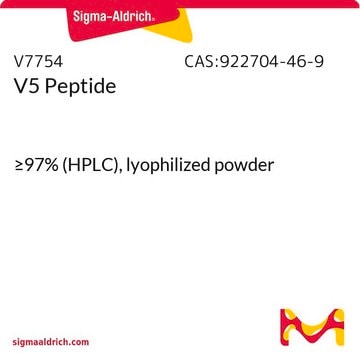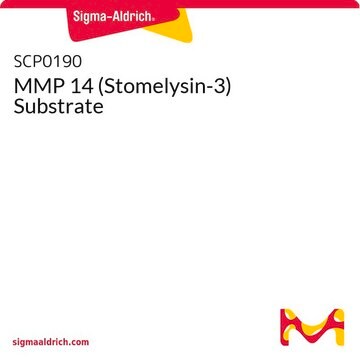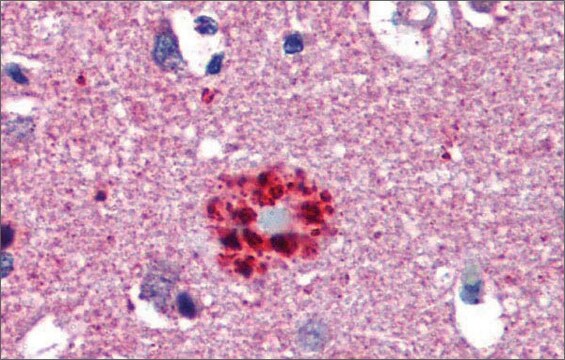SML2627
Connexin43 mimetic peptide 5 trifluoroacetate salt
≥95% (HPLC)
Synonim(y):
Peptide 5 trifluoroacetate salt, VDCFLSRPTEKT trifluoroacetate salt, Val-Asp-Cys-Phe-Leu-Ser-Arg-Pro-Thr-Glu-Lys-Thr trifluoroacetate salt
Zaloguj sięWyświetlanie cen organizacyjnych i kontraktowych
About This Item
Wzór empiryczny (zapis Hilla):
C60H98N16O20S · xC2HF3O2
Numer CAS:
Masa cząsteczkowa:
1395.58 (free base basis)
Kod UNSPSC:
12352200
NACRES:
NA.77
Polecane produkty
Próba
≥95% (HPLC)
Postać
lyophilized powder
kolor
white to beige
temp. przechowywania
−20°C
Działania biochem./fizjol.
Connexin43 mimetic peptide 5 is a blocker of connexin43 hemichannels that inhibits gap junction channels following CNS injury. Peptide 5 was designed to bind to extracellular regions of the connexin43 protein.
This page may contain text that has been machine translated.
Kod klasy składowania
13 - Non Combustible Solids
Klasa zagrożenia wodnego (WGK)
WGK 3
Temperatura zapłonu (°F)
Not applicable
Temperatura zapłonu (°C)
Not applicable
Certyfikaty analizy (CoA)
Poszukaj Certyfikaty analizy (CoA), wpisując numer partii/serii produktów. Numery serii i partii można znaleźć na etykiecie produktu po słowach „seria” lub „partia”.
Masz już ten produkt?
Dokumenty związane z niedawno zakupionymi produktami zostały zamieszczone w Bibliotece dokumentów.
Yilin Mao et al.
Experimental brain research, 235(10), 3033-3048 (2017-07-21)
Systemic administration of a Connexin43 mimetic peptide, Peptide5, has been shown to reduce secondary tissue damage and improve functional recovery after spinal cord injury (SCI). This study investigated safety measures and potential off-target effects of Peptide5 systemic administration. Rats were
Yeri Kim et al.
Biochimica et biophysica acta. General subjects, 1861(2), 68-78 (2016-11-07)
Non-selective Connexin43 hemichannels contribute to secondary lesion spread. The hemichannel blocking peptidomimetic Peptide5, derived from the second extracellular loop of the human Connexin43 protein, prevents lesion spread and reduces vascular permeability in preclinical models of central nervous system injury. The
Helen V Danesh-Meyer et al.
Brain : a journal of neurology, 135(Pt 2), 506-520 (2012-02-22)
Connexin43 gap junction protein is expressed in astrocytes and the vascular endothelium in the central nervous system. It is upregulated following central nervous system injury and is recognized as playing an important role in modulating the extent of damage. Studies
Nasz zespół naukowców ma doświadczenie we wszystkich obszarach badań, w tym w naukach przyrodniczych, materiałoznawstwie, syntezie chemicznej, chromatografii, analityce i wielu innych dziedzinach.
Skontaktuj się z zespołem ds. pomocy technicznej








